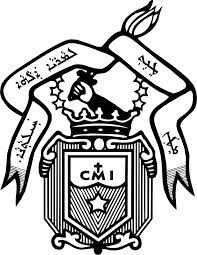
The Order of the Brothers of the Blessed Virgin Mary of Mount Carmel, known as the Carmelites or sometimes by synecdoche known simply as Carmel, is a mendicant order in the Catholic Church for both men and women. Historical records about its origin remain uncertain; it was probably founded in the 12th century on Mount Carmel in what is now Israel.

Augustinians are members of several religious orders that follow the Rule of Saint Augustine, written in about 400 AD by Augustine of Hippo. There are two distinct types of Augustinians in Catholic religious orders dating back to the 12th–13th centuries:

The Scapular of Our Lady of Mount Carmel belongs to the habit of both the Carmelite Order and the Discalced Carmelite Order, both of which have Our Lady of Mount Carmel as their patroness. In its small form, it is widely popular among Catholics. Today, it serves as the prototype of all devotional scapulars. The liturgical feast day of Our Lady of Mount Carmel, July 16, is popularly associated with the devotion of the Scapular.

The term third order signifies, in general, lay members of Christian religious orders, who do not necessarily live in a religious community such as a monastery or a nunnery, and yet can claim to wear the religious habit and participate in the good works of a great order. Roman Catholicism, Lutheranism and Anglicanism all recognize third orders.

Our Lady of Mount Carmel, or Virgin of Carmel is a Roman Catholic title of the Blessed Virgin Mary venerated as patroness of the Carmelite Order.

Simon Stock, OCarm was an English Catholic priest and saint who lived in the 13th century and was an early prior of the Carmelite Order. The Blessed Virgin Mary is traditionally said to have appeared to him and given him the Brown Scapular. Although his visionary meeting with Mary is likely legendary, popular devotion to Stock is usually associated with devotion to Our Lady of Mount Carmel.

Saint Kuriakose Elias Chavara, CMI was an Indian Syro-Malabar Catholic priest, religious, philosopher and social reformer. He is the first canonised Catholic male saint of Indian origin and was a member of the Syro-Malabar Church, an Eastern Catholic church.

The Carmelites of Mary Immaculate abbreviated CMI, formerly also known as the Servants of Mary Immaculate, is a Catholic clerical religious congregation of pontifical right for men of the Syro-Malabar Catholic Church, and is the largest such congregation in the Syro-Malabar Church.

Veronica of the Passion, OCD was an Ottoman-born English Catholic nun who founded the Sisters of the Apostolic Carmel, a religious congregation for women based in India.

The Discalced Carmelites, known officially as the Order of the Discalced Brothers of the Blessed Virgin Mary of Mount Carmel or the Order of Discalced Carmelites, is a Catholic mendicant order with roots in the eremitic tradition of the Desert Fathers. The order was established in the 16th century, pursuant to the reform of the Carmelite Order by two Spanish saints, Teresa of Ávila (foundress) and John of the Cross (co-founder). Discalced is derived from Latin, meaning "without shoes".
The Third Order of Saint Francis is a third order in the Franciscan tradition of Christianity, founded by the medieval Italian Catholic friar Francis of Assisi.

The Third Order of Saint Dominic, also referred to as the Lay Fraternities of Saint Dominic or Lay Dominicans since 1972, is a Catholic third order which is part of the Dominican Order.

The Carmelite Monks or Monks of the Most Blessed Virgin Mary of Mount Carmel are a public association within the Diocese of Cheyenne, dedicated to a humble life of prayer. The Wyoming Carmelites claim loyalty to the Magisterium of the Catholic Church and to the Carmelite charism. Their life includes strict separation from the world and the living of the cloistered Carmelite spirituality and way of life established by John of the Cross and Teresa of Jesus. In accord with the Carmelite Rule, they engage in manual labor and the study of Carmelite spirituality in the solitude of the mountains, with the firm hope of attaining to Union with God.

The Martyrs of Compiègne were the 16 members of the Carmel of Compiègne, France: 11 Discalced Carmelite nuns, three lay sisters, and two externs. They were executed by the guillotine towards the end of the Reign of Terror, at what is now the Place de la Nation in Paris on 17 July 1794, and are venerated as beatified martyrs of the Catholic Church. Ten days after their execution, Maximilien Robespierre himself was executed, ending the Reign of Terror. Their story has inspired a novella, a motion picture, a television movie, and an opera, Dialogues of the Carmelites, written by French composer Francis Poulenc.

The Secular Order of Discalced Carmelites, formerly the Secular Order of Discalced Carmelites of the Blessed Virgin Mary of Mount Carmel and of the Holy Mother Saint Teresa of Jesus, is a third order of Catholic lay persons and secular clergy associated with the Discalced Carmelites.
Charism = Be holy and lead others to holiness Superior General =Mother Grace Therese CMC

Théodelinde Bourcin-Dubouché, known commonly as Marie-Thérèse of the Heart of Jesus, was a Roman Catholic French nun, artist, and founder of the Sisters of Adoration in Paris, France. The cause for her canonization has been formally accepted by the Holy See, and thus she has been declared "venerable".

Eliswa Vakayil TOCD, religious name Eliswa of the Blessed Virgin Mary, is the foundress of the first indigenous Carmelite congregation for women in India. She was the first religious sister from Kerala, the southern most state of India; she established the first convent school, boarding house and orphanage for girls in Kerala.















